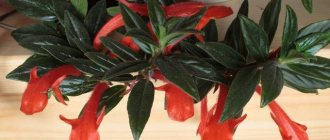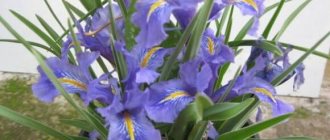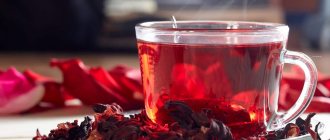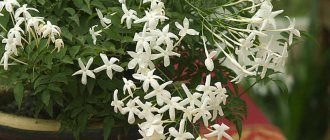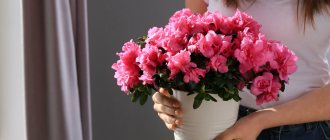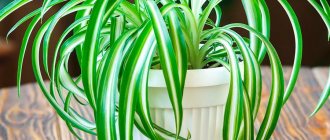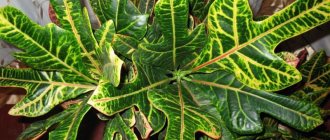In the homes of indoor plant lovers you can find a beautiful representative of the tropical forests - a flower with an unusual name. reo (Latin Rhoeo). In the wild, rheo lives on the moist soils of America and Africa, but it often grows on rocky mountain slopes.
Reo is quite unpretentious and gets along well next to other common indoor potted plants, and with proper care it pleases its owners with a colorful and spectacular appearance.
Reo belongs to the Commelinaceae family (lat. Commelinaceae) and is a relative of Tradescantia, golden mustache and zebrina, traditional for domestic flower growers. The plant is separated into a separate genus, which is called Reo (Latin Rhoeo), and some botanists classify Reo as a member of the genus Tradescantia.
In common parlance, this flower is sometimes called the “boat of Moses” because of its dense, long, pointed leaves.
Reo is a perennial with long (about 30 cm) leaves painted in different colors. The leaves are green on top, sword-shaped with dense, fleshy pulp inside. The color of the leaves below can range from dark green to purple with a purple tinge. Depending on the variety, the leaf blades may have white longitudinal stripes or bright, burgundy, violet-lilac stains.
Reo has a dense, upright and gnarled stem, from which multi-colored leaves and a well-developed rhizome stretch upward in different directions. To form bushiness, the upper shoots and trunk are pinched, and then the rheo thanks the owners with a lush cap that covers the pot and extends beyond it. To make the plant look more impressive, different varieties are mixed when planted in one pot. As a result, you get not only a luxurious bush, but also a natural composition that is captivating with its varied colors.
Reo can bloom even indoors. However, small white inflorescences appear only with proper care and watering. It is because of the unusual arrangement of the inflorescences of the rheo that it received the name of the species - rheo spathaceae (lat. Rhoeo spathaceae). The thing is that small white flowers bloom at the base of the leaf and, as it were, are covered with 2-3 bracts. In ideal conditions, the plant pleases its owners with white flowers all year round. However, if there is a lack of microelements, light or moisture, reo may not produce a single inflorescence. In comparison with other flowering ornamental plants, reo does not have any special value, but its inflorescences look harmonious in the color scheme of sharp, fleshy leaves of various colors.
In its homeland, reo is considered medicinal. Squeezes from the leaves are used to treat periodontal disease and stop bleeding gums, and decoctions from adult shoots are used to treat colds and inflammatory processes. In addition, the leaves of the plant are used by residents of the tropics as a disinfectant: the juice of the leaves is applied to wounds, burns and calluses.
Flowers with bright foliage at the top
A plant with brightly colored foliage is the goal of any gardener. If such a miracle is not yet in the apartment, then you can choose one of the listed copies:
- poinsettia;
- Cordyline;
- irezine;
- nidularium;
- triangular oxalis.
Indoor flower with red leaves - an original interior element
This is a list of the most popular plants that have red leaves at the top. To ensure that indoor plants are always pleasing to the eye and their color does not fade, you need to familiarize yourself with the nuances of care.
Poinsettia
Poinsettia, or Christmas star, as it is popularly called, is a variety of Euphorbiaceae. The second name arose due to the presence of bright red foliage at the top of the cap, which usually appears at the beginning of winter. The plant is native to Mexico and Central America. It has a number of subspecies:
- spherical;
- large-horned;
- sparkling.
Poinsettia
Poinsettia is not picky when it comes to care. The main thing is to place the plant in a place without drafts and avoid strong temperature changes. Feels uncomfortable in very hot weather and cannot tolerate strong shade. Grows well in diffused light. She needs to be provided with abundant watering and constant spraying. In winter, it sheds its leaves. During this period it looks unpresentable. Propagated by cuttings - shoots containing at least five leaves.
Important! Euphorbia poinsettia juice is poisonous. It may cause minor skin burns. All pruning and replanting procedures are performed with gloves.
Cordilina
A subshrub from the Agave family from the tropics resembles a palm tree. But it has nothing to do with palm trees. More likely, a relative of the dracaena. It grows up to half a meter in height.
It attracts with its unusual appearance, or rather with its elongated red leaves, which are tightly spaced in relation to each other. As it grows, the lower leaves fall off, and the upper ones form a chic hat. There are varieties of cordyline, differing in foliage colors:
- green;
- red and white.
Cordilina
Cordyline must be placed in a warm place where rays of diffused light fall. Does not like frequent watering. Optimal temperature:
- in summer 20-23 °C;
- in winter 13-17 °C.
It responds well to systematic moistening and annual replanting. Overmoistening is detrimental to cordyline.
Irezine
An unusually bright flower from the Amaranthaceae family. Most often found with leaves that have an epileptic shape and a red-burgundy color. In addition, there are varieties with greenish leaves with crimson veins.
Irezine
Irezine is unpretentious in care. It develops well in diffused light and does not respond to minor temperature changes. Can tolerate drought and low air humidity readings.
Nidularium
A house plant native to the tropics. Belongs to the Bromeliaceae family. The flower is distinguished by the absence of a stem. Sharp green leaves emerge directly from the base. Red leaf plates appear at the top of the plant during the flowering period.
Nidularium
After flowering, the rosette disappears, and in its place several new shoots appear, which also begin to bloom. In this way, nidularium multiplies quickly.
Important! The plant must be protected from direct sunlight, watered frequently and maintained at a high level of humidity.
Oxalis triangularis
The plant is stemless, belongs to the sorrel family, popularly known as hare cabbage. The foliage is carved, like clover, red with a purple tint. During the daytime, the leaves tend to rise, and in the evening they begin to fall. It has another name - Madame Butterfly because of the shape of the leaf, which resembles a butterfly.
Oxalis triangularis
Indoors, it is located in a place that is well lit. Otherwise, the color of the foliage will change, darken and approach a greenish tint. Watering should be moderate. Periodically in the spring and summer they are fed with liquid fertilizers. In winter, when at rest, it grows its crown.
Pest and disease control
Oxalis has excellent strong immunity, which is partly due to its high acid content. Even fungus and spider mites rarely affect it. Therefore, no measures are needed here. Just use medicinal products and adjust the humidity!
Photo: lifeflower.ru
Epipremnum (50 photos): types, cultivation and care at home
Plants with reddish-green foliage
What is the name of an indoor flower with red flowers?
The choice of indoor plants with variegated colors in red tones is not too large. There are plants with a variety of colors - spotted, streaked, striped.
The most popular indoor flowers with red-green leaves include:
- croton;
- coleus;
- aglaonema;
- royal begonia;
- cryptanthus;
- hypoesthes;
- caladium.
Each of them has its own characteristics, both in appearance and in care.
Plants with red color on top
Indoor flowers with original leaf colors look impressive. Their upper part has a bright red-pink hue, and the lower part is close to green.
Begonia royal
It looks quite impressive, pleasing the eye with the burgundy-red color of the leaf plate. Among its relatives it is the leader in breeding at home. The foliage is large and heart shaped. The plant reaches a height of about 40 cm.
Begonia royal
Maintenance is easy. Transplants and fertilizing are carried out rarely and do not require spraying. Prefers a warm room, good lighting and nutritious soil. Does not tolerate waterlogging of the soil and temperature drops to −10 °C.
Croton
A houseplant with red-green leaves, which belongs to the Molochai family. It has a bright color on the upper part of the foliage, with a contrasting pattern of yellow or white veins on a red background. The bottom of the leaf is green.
Croton
Requires constant care, is afraid of drafts and bright lighting, especially direct rays of the sun. The optimal temperature in summer is 20 °C. In winter it feels great at 15 °C. Croton needs to be watered regularly and constantly sprayed. In the spring-autumn period it requires monthly fertilizing.
Important! To form a beautiful croton crown, the plant is constantly pinched. The procedure begins when the plant reaches 15 cm in height.
Coleus
The houseplant coleus is often popularly called the poor man's croton. First of all, because of its similarity with croton, variegated colors, and secondly, because of its ease of care. Belongs to the Lamiaceae family, has carved leaves with a fancy color.
Coleus
It grows up to 40 cm in height. It can be propagated by both seeds and cuttings. Loves warmth and high humidity, periodic feeding.
Flowers with bright colors below
Specimens of plants with an unusual color look interesting: the lower part is red, and the upper part is variegated. A striking representative of this species is Aglaonema.
In appearance it resembles Dieffenbachia. Homeland: India, China and South Asia. The flower is stemless, but over time a short stem is formed. The lower part of the leaf is painted red, and at the top in the middle there is a soft pink stripe on a green background.
Aglaonema
Prefers diffused lighting and develops well at a temperature of 20-25°C. In summer, it is necessary to water regularly; in winter, only lightly moisten the soil.
Oxalis care
Oxalis loves warmth and does not tolerate frost. In the summer it can be taken outside or planted in the garden, but wintering is strictly indoors. Otherwise, it causes almost no problems, despite its exotic appearance.
Temperature
The ideal temperature for sorrel is from 20 degrees, but it definitely needs fresh air. In summer, it is better to move indoor flowerpots to the balcony or at least ventilate them more often. In winter, keep the temperature to 12-18 degrees.
Photo: profile.ru
Lighting
Oxalis definitely needs a long sunny day, up to 14 hours. But at the same time, diffused light is desirable, so by noon it is shaded. Indoor flowerpots will need additional lighting in winter.
Photo: gardendesign.com
Watering
In summer, sorrel is watered frequently and intensively, as soon as the top layer dries. Garden sorrel usually has enough natural precipitation. During the dormant period, watering once every 1-1.5 months is sufficient. In addition, in hot weather, sorrel can be sprayed. But in general, it adapts well to any air humidity.
Photo: cvetyphoto.blogspot.com
The soil
Choose airy, light soil for deciduous plants. All-purpose mixtures are also suitable, but you should add baking powder to them. In the garden, the soil is dug up in advance with peat and humus.
Photo: domashniecvety.ru
Fertilizers and fertilizing
For feeding, use mineral mixtures with nitrogen and phosphorus - for the leaves and root system. But a very low concentration is needed - twice as weak as the recommended norm. Garden species can be fed with organic matter, and indoor species with wood ash and succinic acid.
Photo: oir.mobi
Trimming
To keep the sorrel looking neat, it needs to be thinned out periodically. This applies to both indoor bushes and garden ground cover species. And always remove dry leaves and faded buds.
Photo: domashniecvety.ru
Wintering
This is true for garden species. In the fall, the above-ground part of the sorrel dies, and then you need to carefully dig up the tubers and leave them to overwinter in a dark, cool place. At the beginning of spring, dig them into the soil with sand in containers, and only then plant them in the garden.
In the southern regions, tubers can be left to overwinter in open ground. But still, after the ground part dies, you need to mulch them with a thick layer so that they do not freeze.
Photo: domashniecvety.ru
Transfer
Before transplanting, you must first stop watering and dry the earthen ball. After this, carefully transfer the plant into a pot a couple of centimeters larger. This is necessary, among other things, to stimulate the growth and formation of daughter tubers. In most cases, wood sorrel calmly tolerates transshipment even during flowering.
Photo: facenewss.ru
Date palm (50 photos): types, care and cultivation at home
Houseplants with spotted colors
What is the name of an indoor flower with long narrow leaves?
Many of the brightly colored varieties that exist are spotted or streaked. Such specimens also look interesting and have their admirers.
Codeium
A flower from the Euphorbiaceae family is picky about its conditions. That is why you rarely see it in an apartment or house. Feels great in greenhouses or winter gardens. It is a shrub that in natural conditions grows up to 3 m, in greenhouses it does not exceed 1.5 m. It has several subspecies that differ from each other in the color of the crown. On the red background of the foliage there are spots of yellow, orange and white. Veins of contrasting color are always present. This makes the plant even more interesting.
Codeium
Note! It should be kept in good lighting, but avoid direct sunlight. Provide regular watering. It is better if the pot is placed on a tray with pebbles moistened with water. During flowering, additional spraying is required.
Cryptanthus
The flower, native to Brazil, belongs to the Bromeliad family. There are no stems, the leaf blade originates from the root base. The leaves are shaped like a starfish with a sharp edge. The color is bright: the base of the leaf is bright crimson with the presence of greenish or gray veins in the form of stripes.
Cryptanthus is unpretentious in cultivation. Heat-loving, loves high humidity and frequent watering.
Hypestes
A herbaceous perennial belonging to the Acanthus family. The foliage is red-green, covered with a spotted pattern in a chaotic form. It grows well, reaching a height of 50 cm. It has strong and hard stems, densely covered with foliage.
Hypestes
Loves frequent watering and good lighting. In shaded areas, the leaves turn pale and lose their attractiveness.
Important! Depending on the conditions of detention and the amount of fertilizing, hyposthes can change the color of the foliage.
All presented types of indoor plants with red leaves are original and have their own attractiveness. Each of them can dilute the interior of the apartment, becoming a bright accent. All that remains is to choose the plant you like and provide it with the necessary conditions.
Reo – keeper of positive energy
It is believed that reo is able to protect a house from bad energy, and its owners from the destruction of the biological field. Give this type of Tradescantia to those who are tormented by unkind thoughts, bad mood or resentment, and the plant will help them find happiness and harmony.
If you plant reo in the house, the most lethargic and melancholic person will acquire an active mood and stop moping. Reo can dispel even gloominess, gloom and rancor in a person. The plant will protect its owner from bad deeds, help improve relationships with others and nullify all destructive energy.
In addition, the boat of Moses can bestow its owner with eloquence, power of thought and action. Those who have this flower in their home acquire the ability to speak beautifully and have a great chance of improving their career.
Reo also has a huge impact on creative people. The presence of this plant expands the power of creative thought, helps to find new ideas and breathe life into them.
If you purchased a reo with white flowers, then already with the first flowering, bad thoughts and premonitions will leave you. But reo with variegated leaves will help protect the internal love harmony of the family from external intrusions.
People who believe in the power of green plants have always considered reo a talisman against the evil eye. Those who have this plant growing and blooming luxuriantly in their home are not afraid of the powers of black magic. If the boat of Moses develops safely and has no signs of illness, then everything is fine in the family or love relationship. If there are no apparent reasons for the leaves falling or turning black, but the plant is losing shoots, then your green pet has received the black energy directed against you.
***
Whether you believe in omens and superstitions or not is up to you. One thing is for sure, reo is a magnificent house plant that has rightfully earned a place in our cozy homes.


